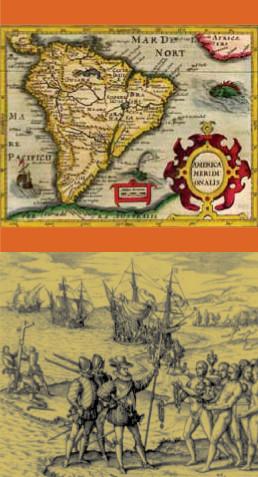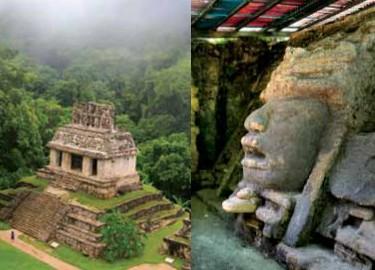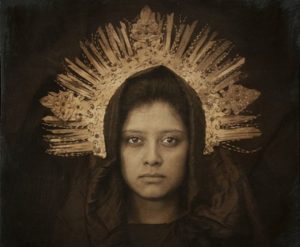Conquest, Confession, and Mission
The encounter between Christianity and the religions of Latin America began with Columbus’s travels. For over five hundred years, Christians—first Catholics, then Protestants, and even marginal Christian groups—have evangelized, persecuted, and marginalized native peoples. They have also sought to understand indigenous religions, and many Christians have defended native peoples against the onslaught of outside invaders. The religions of the Americas have survived and have even influenced Christian practice in the region. Many forms of popular Catholicism (and some forms of popular Pentecostalism) reflect the impact of native religions. And as native peoples have gained political and social power there has also been a resurgence of native religious practice.
 The growth of popular religious practices and the resurgence of native religions in Latin America call evangelical Christians to re-think how to do mission among the native peoples of the region. The evangelism models of the past created a fundamentally uneven relationship that must be taken into account as evangelicals think about future mission. For this reason any conversation about interreligious interaction must begin with a review of that history, something crucial for understanding the current relations between evangelical Christianity and indigenous religions. This then provides the basis for thinking differently about mission among indigenous peoples.1
The growth of popular religious practices and the resurgence of native religions in Latin America call evangelical Christians to re-think how to do mission among the native peoples of the region. The evangelism models of the past created a fundamentally uneven relationship that must be taken into account as evangelicals think about future mission. For this reason any conversation about interreligious interaction must begin with a review of that history, something crucial for understanding the current relations between evangelical Christianity and indigenous religions. This then provides the basis for thinking differently about mission among indigenous peoples.1
The Religious Encounter: Spanish and Portuguese Catholicism
When the Portuguese and the Spaniards began their global exploration, the pope issued a number of papal bulls which gave those kings authority to explore and conqueror any lands not under a Catholic king as long as evangelization was part of the process. And in 1508 the Spanish king also gained royal patronage that gave him authority to name the bishops of the Catholic Church in the lands conquered by Spain.
The process of evangelization immediately raised the question of whether the indigenous could become Christians. Some were from more “advanced” societies, but many were considered savages because of their social and cultural practices. An extensive theological debate ensued in Spain with the conclusion that the indigenous could become Catholics and thereby Spanish citizens. This conclusion would be affirmed in theory, throughout the colonial period, but often not in practice.
As part of the evangelization process several religious orders entered the region. Because they answered directly to the pope, their
role in Latin America was often in tension with the political authorities. Nonetheless, these missionary priests went to some of the most dangerous areas in the region, taking the faith with them. One of the models they used to evangelize and “civilize” the more nomadic peoples was to develop missions: places where the indigenous were organized into communities, evangelized, and taught skills so that they might fit in Spanish colonial society. There were also other tools that combined the tasks of evangelization and conquest. On the one hand, the Requerimiento was a document to be read to all peoples encountered by Spaniards. It stated that the Spaniards were coming by authority of the pope and his delegated representative, the Spanish king, and that the people were to submit to their authority or be forcibly submitted. Spanish settlers were also allowed to develop Encomiendas on large tracts of land, which included the native inhabitants. They were allowed to “use” the labor of the people, but were required to teach them Christian faith.
This joining of evangelization and conquest became the model for relations between the peoples of the Americas and European Catholics. For Spaniards the expansion into the Americas was a continuation of the Crusades whereby they had freed the Iberian Peninsula from Muslims. They were now extending Christian faith into the Americas and expanding the rule of the Spanish king.
In many ways the movie The Mission represents the complexities of the Catholic evangelistic model in Latin America. On the one hand, the movie presents the commitment of the Jesuit missionaries and their willingness to educate and protect the native peoples. But political and economic interests were always immediately in the background. At the end of the day the economic and political interests always seemed to win, though some semblance of faith remained among the people.
In the process of sharing the Catholic faith with native peoples, one of the key models used by the priests was that of connecting Catholic practice with previous indigenous religions. The most famous case of this type of enculturation is the Virgin of Guadalupe. The Guadalupe shrine and practices are closely linked to the Aztec goddess Tonantzin. The shrine was built at Tepeyac, where Tonantzin had been revered, and popular veneration of Guadalupe today is connected to the pre-Colombian worship of Tonantzin. To this date Guadalupe is the most venerated virgin apparition in the Americas and was declared the Patroness of the Americas by Pope John Paul II.
 By the end of the colonial period, nearly all the indigenous peoples of Latin America formally confessed Catholic faith; they had been conquered and baptized into the faith. But it was not clear how they understood their new faith or how they connected their old religions with Catholicism. Evangelization and conquest had made (almost) everyone Catholic, but the old practices did not disappear. People continued their old religious practices either secretly or in Catholic guise. The status of indigenous religions became more complex after the independence of the countries of Latin America. Independence neither brought more rights to the indigenous, nor improved their situation. In places where they were part of missions, the missions were secularized and the indigenous peoples lost what they had, since the missions had officially been in the hands of the religious orders. And since many of the priests and the religious were Spaniards, they were kicked out of the newly independent countries. Thus, the countries of Latin America became independent the indigenous peoples were very much on the margin in the social and political leadership’s vision for the future. At best they were cheap labor for the economies of the new republics. They were all Catholics and technically citizens of the new countries, but they held a very tenuous place in the new Latin America.
By the end of the colonial period, nearly all the indigenous peoples of Latin America formally confessed Catholic faith; they had been conquered and baptized into the faith. But it was not clear how they understood their new faith or how they connected their old religions with Catholicism. Evangelization and conquest had made (almost) everyone Catholic, but the old practices did not disappear. People continued their old religious practices either secretly or in Catholic guise. The status of indigenous religions became more complex after the independence of the countries of Latin America. Independence neither brought more rights to the indigenous, nor improved their situation. In places where they were part of missions, the missions were secularized and the indigenous peoples lost what they had, since the missions had officially been in the hands of the religious orders. And since many of the priests and the religious were Spaniards, they were kicked out of the newly independent countries. Thus, the countries of Latin America became independent the indigenous peoples were very much on the margin in the social and political leadership’s vision for the future. At best they were cheap labor for the economies of the new republics. They were all Catholics and technically citizens of the new countries, but they held a very tenuous place in the new Latin America.
Arrival of the Protestants: Literacy, Education, and Bible Translation
When Protestant missionaries arrived in Latin America in the nineteenth century, they often emphasized literacy and education. Their commitment to the poor and marginalized focused in this direction. These early missionaries were convinced that the people needed to be able to read the Bible so that they could understand the gospel. Their work among the indigenous usually included this focus, along with basic social services.
The most prominent way that Protestants interacted with native peoples during the twentieth century was through Bible translation. Wycliffe Bible Translators has served as the model for most translation projects. Translators connected with isolated communities and worked to learn the language and reduce it to writing. They all had some social science training and many were anthropologists. In the process of learning the language they learned about religion and culture. Their affirmation of the importance of the people’s language often also created a new affirmation of the culture and the religion.
Once a language was understood and given written form, the translators began literacy programs. Bible portions were then translated and people were given copies, since the missionaries firmly believed that God would work through the Word and bring conversion. This process has produced Bibles or Bible portions in many languages and dialects, but it has also had other effects. Native peoples rediscovered their voice in the midst of societies that had neglected or abused them. Moreover, through the process of talking about their religious and cultural framing, many reaffirmed the value of their ancestral systems. Some of the informants in the translation process later became proponents of their ancestral religious systems.
 Though Protestant Bible translators have done more to learn about indigenous languages than any Latin American government or university, their work has not been without controversy. The most direct critique has been the fact that the process is closely linked to evangelization. But many missionaries have also been accused of taking Western values into the communities. During the Cold War many Wycliffe missionaries were accused of being witting or unwitting agents of US expansionism in the region. Given the role of globalization today, the influence of outside values is much stronger than anything missionaries might do. But their presence in native communities raises the questions of the connection between evangelization and the respect for native peoples and their cultures.
Though Protestant Bible translators have done more to learn about indigenous languages than any Latin American government or university, their work has not been without controversy. The most direct critique has been the fact that the process is closely linked to evangelization. But many missionaries have also been accused of taking Western values into the communities. During the Cold War many Wycliffe missionaries were accused of being witting or unwitting agents of US expansionism in the region. Given the role of globalization today, the influence of outside values is much stronger than anything missionaries might do. But their presence in native communities raises the questions of the connection between evangelization and the respect for native peoples and their cultures.
Indigenous Religions among Christians in Latin America Today
In spite of over five hundred years of interaction, probably the most common perspective of indigenous religions through most of the nineteenth and twentieth centuries, both Catholic and Protestant, has been that of quaint and backward practices of peoples who are being absorbed into Latin American societies. In some areas native peoples continue to be cheap labor and sometimes almost indentured servants. They continue to be pushed off their ancestral lands and forced to abandon their traditional practices. The European sense of superiority has meant that those in power in Latin America have usually seen little of value in indigenous practices.
Nonetheless, those countries with significant ruins built by the empires of the pre-colonial period, such as Peru, Guatemala, and Mexico, have found that talking about ancient religions and societies is good for tourism. There has been a renewed interest in the religions of the pre-colonial period since most of the surviving structures had a clear religious purpose. But often this interest has only extended to those indigenous peoples who died hundreds of years ago. Many times the descendants of those who built those structures are marginalized from the benefits accrued by the expanding tourism.
 The vast majority of indigenous peoples in Latin America today are officially Roman Catholic, though a growing percentage are becoming Protestants. But they are a part of a Catholicism that has formally, and informally, adopted and adapted indigenous practices. There are many places, such as the principal church in Totonicapán, Guatemala, where the connection is very direct. This church, built on the ruins of a pre-colonial temple, still has an indigenous altar at the base of the stairway up to the church. Many people make their offerings and sacrifices there before going into the church. Also, many of the practices of the religious fraternities that sustain that church are closely linked to old Mayan practices, though they may superficially look Catholic.
The vast majority of indigenous peoples in Latin America today are officially Roman Catholic, though a growing percentage are becoming Protestants. But they are a part of a Catholicism that has formally, and informally, adopted and adapted indigenous practices. There are many places, such as the principal church in Totonicapán, Guatemala, where the connection is very direct. This church, built on the ruins of a pre-colonial temple, still has an indigenous altar at the base of the stairway up to the church. Many people make their offerings and sacrifices there before going into the church. Also, many of the practices of the religious fraternities that sustain that church are closely linked to old Mayan practices, though they may superficially look Catholic.
There are also people who continue the “old” practices more underground. In the past these practices have been called witchcraft and the leaders have been persecuted. So these practices have tended to stay out of the public view. But because of the strong interaction with Catholicism it is not always clear how “pure” these practices are. They often follow patterns that look Catholic, even as Catholic practice often looks indigenous.
The Catholic models of evangelization in the region often raise the question of syncretism. To what extent do the Catholic religious practices of the region reflect a missiologically crucial enculturation and to what extent has Catholic faith and practice been changed by the encounter with the indigenous religious practices of the people? Of course, after five centuries of interaction, interpretation, and reinterpretation, it is unlikely that one could easily separate one from the other. Of course, another important issue has to do with the significance of attempting this analysis? What would be gained and how would it help the situation?
A changing Latin America has also created new types of spaces for indigenous religions. In places with large indigenous populations, the people have gained political power and some have used that platform to promote their religious practices. The two countries that most stand out are Bolivia and Guatemala. President Evo Morales of Bolivia has openly encouraged the practice of the local religions and publically practices them himself. In Guatemala indigenous religious groups legally organize as such, and at least one expresident, Alvaro Colom, formally became a Mayan priest before he became president of the country.
The growth of Protestantism, particularly Pentecostalism, among the indigenous has created new issues and complexities. Pentecostals take the spiritual claims of the indigenous religions very seriously and interpret many of the practices as satanic. They confront indigenous religions through the lens of spiritual warfare. This has created more conversions toward Pentecostalism. But at times it has also created some questionable interpretations, such as when a large neo-Pentecostal church in Guatemala City blamed Guatemala’s problems on indigenous religions, but never once spoke against the blatant economic and political violence of the powerful against the indigenous.
Another type of tension is seen in some communities in Mexico where Protestants have been forced to leave their homes because they refuse to pay for the traditional Catholic/indigenous feast days, particularly because the money is used to buy liquor. The local caciques (indigenous community leaders) have so much power that they can use popular religious practices against the Protestants with impunity. By refusing to participate in the local celebrations, indigenous Protestants are undermining one of the linchpins of the caciques’ power in the community.
Christian Witness in the Twenty-first Century
A truly Christian witness among the indigenous of Latin America must begin and be framed by confession. Though there have been several types of “formal” confessions, the reality is that most Christians in Latin America continue to treat indigenous peoples disparagingly and not take their religions seriously. The confessions have to go beyond the issue of religious freedom. Land expropriation, forced learning of the national languages, indentured servitude, and other similar actions continue to be part of the treatment of native peoples in the Americas. Any Christian confession has to include recognition of how much Latin American Christians have benefited from this unjust treatment of the indigenous. In particular, Pentecostals and neo-Pentecostals have to be leery of any situation where the oppressed are blamed for the spiritual problems in a country while the oppressors go unchallenged. This is part of the larger problem of evangelization in the modern era—the link between Christendom power and mission. Anywhere the gospel went out alongside a colonializing project, the gospel was adversely affected and the message received was mixed with the political and economic agendas of the colonial power. This issue cannot be avoided anywhere that Europeans—and their direct descendants—have expanded over the last five centuries.
The Cape Town Commitment (2010)2 stated that evangelicals would defend the rights of those who suffer religious persecution and would speak for religious freedom. That commitment will continually be tested in Latin America where indigenous rights, and religious freedom, are often linked to left-wing political agendas and to the tensions between the indigenous and latino populations. Because in this situation Christians have been the oppressors and the beneficiaries of the status quo, it will be particularly complicated to speak on behalf of religious freedom, but it will be particularly important. As we think about the proclamation and call of the gospel among the indigenous today, we do well to remember the commitment of the Iguassu Affirmation (1999):
Religious pluralism challenges us to hold firmly to the uniqueness of Jesus Christ as Savior even as we work for increased tolerance and understanding among religious communities. . . . We also commit ourselves to proclaim the gospel of Jesus Christ in faithfulness and loving humility.3
Taking that seriously in this context will require a lot of humility in the midst of faithfulness. If evangelicals are to live up to this commitment, they will need to focus on models of mission and evangelization that affirm indigenous peoples and cultures so that humility can be at the center of the service in the name of Christ.
Literacy programs continue to provide opportunities to give witness to the willingness to empower indigenous peoples. A project that encourages people to value their language, talk about their faith and culture, and to affirm that God has been with them and their histories continues to be an excellent way for evangelicals to connect the gospel with indigenous peoples. Of course, helping people think about their culture and their faith means that they might reaffirm the value of their traditional faith.
Part of this process implies affirming God’s creation and God’s continuing presence among all peoples. Working from the perspective that all cultures reflect both God’s work and the fallenness of humanity means that evangelicals need to identify and take seriously the gifts and assets of the indigenous cultures within which they work. Part of this process will include encouraging the continuance of practices that affirm God’s work and creation, including connecting these practices to the way indigenous Christians live out their faith. For example, the strong ecological affirmations within many indigenous practices need to be clearly connected to the Christian confession that God is creator of all and that we are stewards of that creation.
As we share the good news of the gospel we also need to build bridges with indigenous faith and practice. We need to look for Christological bridges, places where people see God at work and where we can connect the good news of the incarnation to the life and practices of the people. Many of the indigenous peoples tell stories of God’s work and presence that are not unlike stories of the Old Testament. Evangelicals need to listen and be attentive to the ways that God is already working and connecting.
But evangelicals also need to take a proactive role in supporting and protecting peoples who are being pushed off their traditional lands and away from their traditional ways of life. Globalization has created new types of pressures, and the various people groups will need to make decisions about how they frame their futures and/or interact with the larger society and their globalized world. But Christians, and evangelicals in particular, need to be at the forefront of creating spaces for indigenous peoples to define their own futures, be it on their traditional lands or as they seek to adjust to life in urban Latin America.
Because of the unique history and interactions, interreligious relations will look different in this environment than in other parts of the world. Clearly indigenous and Catholic practices are closely intertwined after centuries of encounter. What might have begun as syncretism has now become part of the faith understanding of many. It is not always clear which has influenced which and how. So the issue is not so much about trying to clarify the past as it is about inviting people to hear the gospel in this context and looking for links, for places where God is at work and where the gospel can be heard as good news in the power of the Holy Spirit.
As evangelicals we confess that it is the Holy Spirit who works through the word of God to transform lives. In the past many evangelicals fell into the trap of assuming that working alongside those in power would make the evangelistic task easier. The evangelistic efforts among the indigenous in Latin America provide glaring examples of the error of that assumption. As evangelicals go forward, the call to humble service in the name of Christ will need to be heeded so that the message is good news to people who for centuries have heard a mixed message.
Endnotes
1This reflection will focus on Latin American indigenous religions with roots in the pre-colonial period. Though African religions are often part of popular religious practice in the region, they will not be directly addressed here. It is also important to note that I write this reflection from an evangelical perspective and as an outsider. I am Latino, worked in Latin America for almost nine years, and maintain links to the region. But my social location is not in the region. So I write this with much humility.
2Available on the Lausanne Movement website, at http://www.lausanne.org/en/documents/ctcommitment.html
3Available on a page of the ReoCities archives, at http://reocities.com/CollegePark/pool/5040/English_version_Iguassu_Affirmation.html


